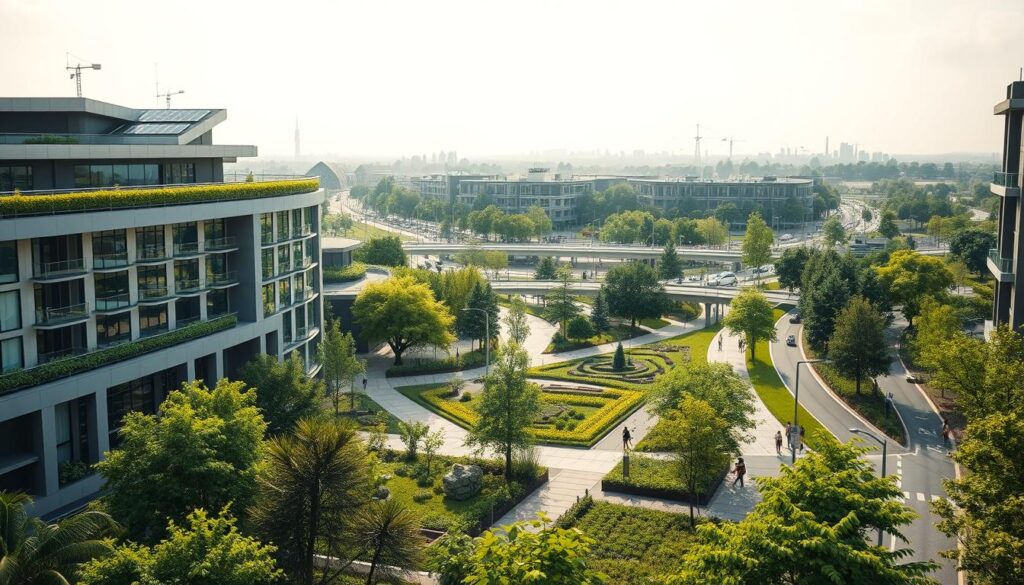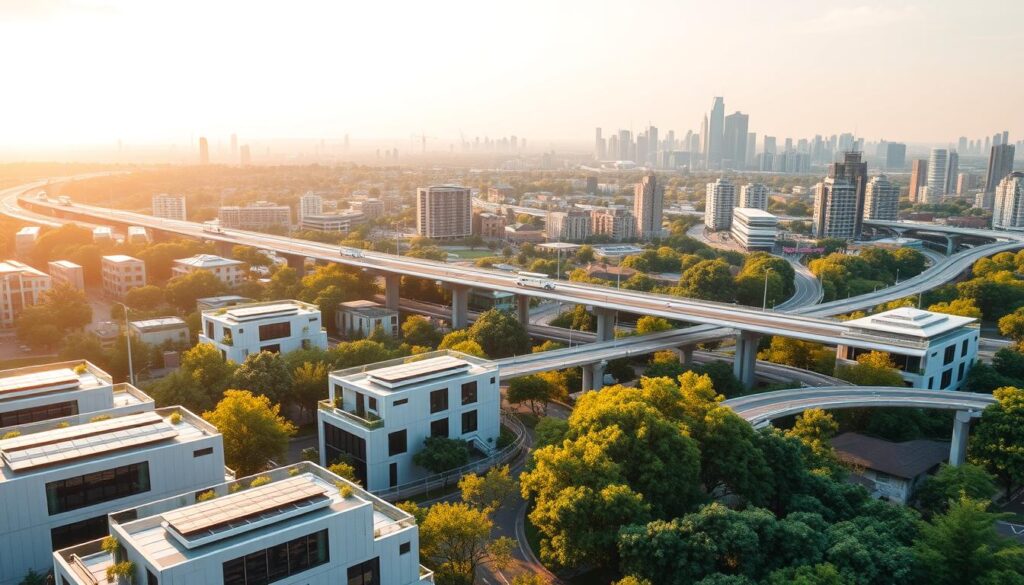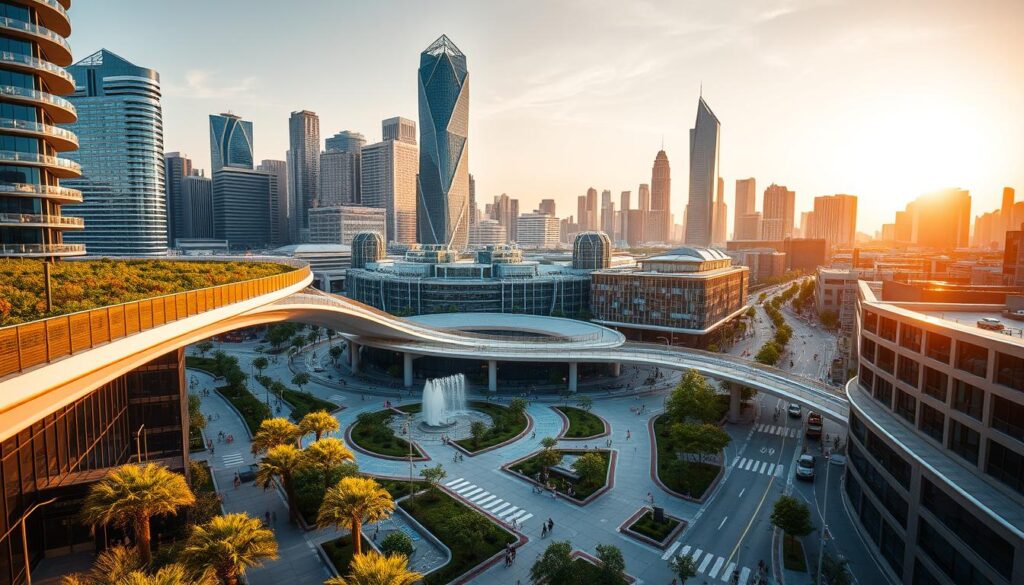As the world grapples with the challenges of climate change, the importance of resilient infrastructure has never been more pronounced. Cities are on the frontline of this battle, with urban areas facing increased risks from flooding, heatwaves, and other extreme weather events.
Civil engineers play a vital role in helping communities adapt and build a sustainable future. By leveraging innovative civil engineering techniques, cities can be designed to withstand the impacts of climate change, protecting both residents and resources.
Key Takeaways
- Cities face growing threats from climate-related disasters.
- Resilient infrastructure is crucial for urban sustainability.
- Civil engineers are key to developing climate-resilient cities.
- Innovative engineering solutions can mitigate climate change impacts.
- Urban planning must prioritize adaptability and resilience.
Understanding Resilient Urban Infrastructure
In the face of growing urban populations and the rising threat of climate change, understanding and implementing resilient urban infrastructure is crucial for the sustainability of cities. The emergence of megacities creates opportunities for a more connected, accessible, and diverse society, but also presents significant challenges, such as limited resources and increased susceptibility to natural and human-made disasters.
Definition and Importance
Resilient urban infrastructure refers to the ability of urban systems to withstand, recover, and adapt in the face of various stresses and shocks. This concept is not just about withstanding disasters; it’s also about creating systems that can evolve and improve over time. The importance of resilient infrastructure lies in its ability to support the well-being of citizens, facilitate economic growth, and ensure environmental sustainability.
According to a quote from the United Nations Office for Disaster Risk Reduction, “Resilience is not just about resisting disasters, but also about bouncing back and being better prepared for the future.”
“Resilience is not just about resisting disasters, but also about bouncing back and being better prepared for the future.”
Key Features of Resilience
Several key features characterize resilient urban infrastructure:
- Redundancy: Having backup systems or components that can take over in case of failure.
- Flexibility: The ability of infrastructure to adapt to changing conditions.
- Robustness: The capacity to withstand stresses without significant degradation.
- Resourcefulness: The ability to diagnose and address problems promptly.
By incorporating these features, cities can enhance their resilience to various challenges, from natural disasters to economic downturns. As cities continue to evolve, the integration of civil engineering innovation will play a pivotal role in shaping resilient urban infrastructure.
The Role of Civil Engineering in Urban Development

As cities continue to expand, the role of civil engineering in urban development becomes increasingly crucial. Civil engineering has long been the backbone of urban infrastructure, providing the foundational elements necessary for cities to function and grow.
Historical Perspective
Historically, civil engineers have played a pivotal role in shaping urban landscapes. From the construction of ancient roads and bridges to the development of modern transportation systems, civil engineering has evolved significantly over the centuries. The adoption of sustainable civil engineering practices has become more pronounced, especially in the face of climate change and urbanization.
Civil engineers are now using predictive climate models to design infrastructure that can withstand the challenges posed by climate change, such as increased rainfall, flooding, and drastic temperature changes. This proactive approach is crucial in ensuring that urban infrastructure remains resilient and adaptable to future environmental conditions.
Current Trends in Civil Engineering
Current trends in civil engineering are geared towards creating more sustainable and resilient urban environments. The integration of innovative materials and technologies is at the forefront of this movement. For instance, the use of advanced materials that are more durable and environmentally friendly is becoming increasingly common.
Moreover, civil engineers are now more focused on sustainable practices that minimize environmental impact. This includes the use of renewable energy sources, green building techniques, and efficient water management systems. The incorporation of these practices not only enhances the sustainability of urban infrastructure but also contributes to a healthier environment for city dwellers.
For more insights on the future of civil engineering and its role in tackling global challenges, visit World Civil Society, which provides valuable information on innovative approaches in civil engineering.
Innovative Materials for Urban Infrastructure
Innovative materials are revolutionizing the way we design and build urban infrastructure. The need for stronger, more resilient structures has driven researchers to develop new materials that can withstand extreme conditions.
Sustainable Materials
Sustainable materials are at the forefront of urban development solutions. These materials are designed to reduce environmental impact while maintaining structural integrity. Examples include recycled materials, low-carbon concrete, and sustainably sourced timber.
The use of sustainable materials not only contributes to a reduction in greenhouse gas emissions but also helps in creating healthier urban environments. For instance, low-carbon concrete can significantly reduce the carbon footprint of large infrastructure projects.
Smart Materials
Smart materials represent another significant advancement in innovative infrastructure design. These materials can adapt to changing conditions, such as temperature or stress, making them ideal for dynamic urban environments.
Examples of smart materials include shape-memory alloys and self-healing concrete. Shape-memory alloys can return to their original shape after deformation, providing enhanced seismic resistance. Self-healing concrete, on the other hand, can repair cracks autonomously, extending the lifespan of structures.
Cost-Effective Solutions
While innovative materials can sometimes be more expensive upfront, they often provide cost-effective solutions in the long run. Durable materials reduce maintenance costs, and sustainable materials can lower energy consumption and extend the life of infrastructure.
Researchers are developing new materials like polymer and metal foams to make structures stronger. These materials are lightweight, rigid, and strong enough to withstand extreme loading events like earthquakes, offering a cost-effective solution for resilient urban infrastructure.
Integrating Technology in Infrastructure Design

The integration of technology in infrastructure design is revolutionizing the way cities are built and managed. This transformation is crucial for creating resilient infrastructure that can withstand the challenges of the future.
Building Information Modeling (BIM)
One of the key technologies being adopted is Building Information Modeling (BIM). BIM allows for the creation of detailed digital models of infrastructure projects, enhancing collaboration among stakeholders and improving project outcomes. According to a chapter on BIM’s role in sustainable infrastructure, available on SpringerLink, BIM significantly improves the efficiency of infrastructure development.
Drones in Surveying
Drones are another technological advancement being utilized in infrastructure design. Equipped with high-resolution cameras and sensors, drones can capture detailed topographic data, monitor construction progress, and inspect infrastructure conditions. This technology is improving the accuracy and safety of surveying processes.
3D Printing Applications
The use of 3D printing in construction is also gaining traction. This technology allows for the rapid creation of complex structures with reduced material waste. For instance, 3D printing can be used to create customized components for buildings, enhancing their resilience to natural disasters.
As discussed on World Civil Society, the integration of technologies like AI and 3D printing is transforming the field of civil engineering, enabling the creation of more resilient and sustainable infrastructure.
| Technology | Application | Benefits |
|---|---|---|
| BIM | Digital modeling of infrastructure | Enhanced collaboration, improved project outcomes |
| Drones | Surveying and inspection | Increased accuracy, improved safety |
| 3D Printing | Rapid creation of complex structures | Reduced material waste, enhanced resilience |
Water Management Solutions for Cities
The challenge of managing urban water resources effectively is being addressed through cutting-edge engineering solutions. As cities grow, they face increasing challenges related to water management, including flooding, water scarcity, and water quality degradation.
Effective water management is critical for urban resilience. Cities are adopting innovative strategies to manage water resources sustainably. Two key approaches are gaining prominence: rainwater harvesting techniques and flood management strategies.
Rainwater Harvesting Techniques
Rainwater harvesting involves collecting and storing rainwater for various uses, reducing the demand on groundwater and municipal water supplies. Techniques include:
- Installing rooftop collection systems that channel rainwater into storage tanks.
- Using permeable pavements that allow rainwater to percolate through the surface, reducing runoff.
- Creating green roofs that absorb rainwater, providing insulation and reducing urban heat island effects.
According to a study by Texas A&M University, innovative rainwater harvesting systems can significantly enhance urban water resilience.
Flood Management Strategies
Flood management is crucial for protecting urban areas from the devastating impacts of flooding. Strategies include:
- Implementing advanced flood warning systems that use real-time data to predict and alert communities of potential floods.
- Designing urban infrastructure with flood resilience in mind, such as constructing levees, floodwalls, and flood-proof buildings.
- Restoring natural habitats like wetlands that can absorb excess water during heavy rainfall events.
As noted by urban planning experts, “Integrating green infrastructure into urban planning is key to managing flood risks and enhancing urban resilience.”
“Green infrastructure not only helps manage stormwater runoff but also provides numerous other benefits, including improved air quality and enhanced biodiversity.”
By adopting these innovative water management solutions, cities can improve their resilience to water-related challenges, ensuring a more sustainable and livable environment for their citizens.
Enhancing Structural Integrity through Innovation

Innovations in civil engineering are revolutionizing the way we design structures to withstand natural disasters. The focus is on creating buildings and infrastructure that are not only resilient but also sustainable. This involves the development of new materials, techniques, and designs that can significantly enhance structural integrity.
Earthquake-Resistant Designs
Earthquake-resistant designs are crucial for saving lives and reducing damage to infrastructure during seismic events. Researchers are developing new designs and materials that can absorb seismic energy, thereby reducing the impact on structures. For instance, the use of base isolation systems allows buildings to move independently of the ground, significantly reducing the transfer of seismic forces.
Another innovative approach is the use of advanced materials like fiber-reinforced polymers (FRP) that can enhance the ductility and strength of structural elements. These materials are being integrated into building designs to improve their resilience to earthquakes.
| Design Feature | Description | Benefit |
|---|---|---|
| Base Isolation Systems | Allows buildings to move independently of the ground during earthquakes | Reduces the transfer of seismic forces to the structure |
| Fiber-Reinforced Polymers (FRP) | Enhances ductility and strength of structural elements | Improves resilience to seismic activity |
Wind-Resistant Structures
Wind-resistant structures are designed to withstand high winds and reduce the risk of damage from wind-borne debris. Innovations in this area include the development of aerodynamic building shapes that can reduce wind loads. Additionally, the use of advanced glazing systems can prevent damage from wind-borne debris and reduce wind pressure on buildings.
The integration of wind turbines into building design is another innovative approach, generating power while withstanding wind forces. Researchers are also exploring the use of smart materials that can adapt to changing wind conditions, further enhancing the resilience of structures.
| Feature | Benefit | Application |
|---|---|---|
| Aerodynamic Building Shapes | Reduces wind loads | High-rise buildings, stadiums |
| Advanced Glazing Systems | Prevents damage from wind-borne debris | Commercial buildings, residential homes |
| Wind Turbines | Generates power, withstands wind forces | Buildings, infrastructure projects |
Sustainable Transportation Solutions
As cities continue to grow, the need for sustainable transportation solutions becomes increasingly important for urban infrastructure resilience. Cities are adopting innovative transportation systems to reduce congestion and improve air quality, making them more livable.
The transportation sector is a significant contributor to urban pollution, and cities are now turning to electric public transit systems as a cleaner alternative. These systems not only reduce emissions but also offer a more efficient way to manage public transportation.
Electric Public Transit Systems
Electric public transit systems are revolutionizing the way cities approach public transportation. By switching to electric buses and trains, cities can significantly reduce their carbon footprint. For instance, cities that have adopted electric public transit systems have seen a reduction in emissions and operating costs.
- Reduced greenhouse gas emissions
- Lower operating costs
- Improved air quality
For more information on transportation network engineering, visit World Civil Society.
Smart Traffic Management
Smart traffic management systems utilize advanced technologies to optimize traffic flow and reduce congestion. These systems can analyze real-time traffic data to adjust signal timings and improve traffic efficiency.
- Real-time traffic monitoring
- Dynamic signal control
- Traffic prediction analytics
The Virginia Tech Transportation Institute is a leader in transportation research, providing valuable insights into smart traffic management systems.
In conclusion, sustainable transportation solutions such as electric public transit systems and smart traffic management are crucial for enhancing urban infrastructure resilience. By adopting these innovative solutions, cities can create a more sustainable and livable environment for their residents.
Green Infrastructure Initiatives

The integration of green infrastructure initiatives into urban development is crucial for creating resilient cities. Green infrastructure, such as urban green spaces and permeable pavements, plays a significant role in managing stormwater runoff, improving air quality, and enhancing the overall sustainability of urban environments.
Urban Green Spaces
Urban green spaces are essential for mitigating the urban heat island effect, improving air quality, and providing recreational areas for residents. These spaces can include parks, gardens, and green roofs.
Some of the key benefits of urban green spaces include:
- Reducing urban heat island effects
- Improving air quality by absorbing pollutants
- Providing habitats for urban wildlife
- Enhancing community well-being through recreational spaces
Permeable Pavements
Permeable pavements are a type of green infrastructure that allows stormwater to percolate through the surface, reducing runoff and alleviating pressure on urban drainage systems. This can help prevent flooding and improve water quality.
| Benefits | Description |
|---|---|
| Stormwater Management | Reduces stormwater runoff by allowing water to percolate through the pavement. |
| Improved Water Quality | Filters out pollutants from stormwater, improving the quality of water that enters waterways. |
| Flood Prevention | Helps prevent urban flooding by reducing the amount of stormwater that enters drainage systems. |
“Green infrastructure is not just a nicety; it’s a necessity for creating livable, resilient cities.”
Community Engagement in Urban Planning
Community engagement is crucial for creating resilient and sustainable urban infrastructure. By involving the community in urban planning processes, cities can ensure that infrastructure meets the needs of their residents, fostering a sense of ownership and cooperation.
Importance of Public Input
Public input is a vital component of effective urban planning. It allows city planners to understand the needs and concerns of the community, ensuring that urban development solutions are tailored to meet these needs. According to a study published on SpringerLink, community engagement can significantly enhance the success of urban development projects.
The process of gathering public input can take various forms, including public meetings, surveys, and online engagement platforms. Each method provides a unique opportunity for residents to contribute their ideas and feedback.
- Public meetings offer a face-to-face interaction where community members can express their opinions and engage in discussions.
- Surveys provide a structured way to collect data on community preferences and concerns.
- Online platforms make it easier for a wider audience to participate, especially those who might not be able to attend physical meetings.
Collaborative Design Processes
Collaborative design processes involve working closely with the community to design infrastructure that is both functional and sustainable. This approach not only enhances the quality of the infrastructure but also fosters a sense of community involvement. The World Civil Society emphasizes the importance of collaboration in achieving sustainable urban development.
| Benefits of Collaborative Design | Description |
|---|---|
| Increased Community Satisfaction | By involving the community in the design process, the final product is more likely to meet their needs and expectations. |
| Improved Sustainability | Collaborative design can lead to more sustainable solutions as it incorporates a wide range of ideas and perspectives. |
| Enhanced Innovation | The diverse input from the community can drive innovation, leading to unique and effective urban development solutions. |
In conclusion, community engagement is a cornerstone of successful urban planning. By prioritizing public input and adopting collaborative design processes, cities can create infrastructure that is resilient, sustainable, and tailored to the needs of their residents.
Challenges Facing Urban Infrastructure Today

Urban infrastructure today is confronted with a multitude of challenges that require immediate attention. The increasing complexity of urban environments, coupled with the pressures of climate change and financial constraints, has made the task of maintaining and upgrading infrastructure a daunting one.
Climate Change Impacts
Climate change is having a profound impact on urban infrastructure. Rising temperatures and more frequent extreme weather events are testing the resilience of cities. For instance, increased flooding and storms are damaging roads, bridges, and buildings, while hotter temperatures are causing pavement and asphalt to degrade more quickly.
Some of the key climate-related challenges include:
- Increased frequency and severity of natural disasters
- Rising sea levels threatening coastal cities
- Extreme temperatures affecting material durability
To address these challenges, cities are turning to innovative infrastructure design and resilient infrastructure planning. This includes designing infrastructure that can withstand extreme weather conditions and incorporating green infrastructure to mitigate the effects of climate change. For more insights on building sustainable cities, visit Aavishkaar School.
Funding and Budget Constraints
Another significant challenge facing urban infrastructure is the issue of funding and budget constraints. Many cities struggle to allocate sufficient funds for infrastructure projects due to competing priorities and limited financial resources.
The lack of investment in infrastructure not only affects the quality of services but also hampers economic growth. To overcome this, cities are exploring alternative funding models and public-private partnerships to leverage additional resources for infrastructure development.
Key strategies for addressing funding constraints include:
- Prioritizing infrastructure projects based on need and impact
- Seeking federal and state funding opportunities
- Engaging in public-private partnerships to secure additional funding
By adopting innovative financing models and focusing on resilient infrastructure planning, cities can better navigate the challenges facing their infrastructure today.
Case Studies of Successful Resilient Projects
Resilient cities are being built around the world, leveraging cutting-edge urban engineering solutions. These projects demonstrate the effectiveness of innovative approaches in creating sustainable and resilient urban infrastructure.
Innovative Approaches in Action
One notable example is the use of green infrastructure in urban planning. Cities like New York and Singapore have incorporated green roofs and permeable pavements to manage stormwater runoff and reduce urban heat island effects. According to a study on resilient infrastructure design, “the integration of green infrastructure can significantly enhance a city’s resilience to climate change” as highlighted in this LinkedIn article.
Another example is the application of advanced materials in construction. For instance, the use of fiber-reinforced polymers (FRP) in bridge construction has improved durability and reduced maintenance costs. As noted by experts, “innovative materials like FRP are revolutionizing the field of urban engineering.”
Lessons Learned
The case studies reveal several key lessons for successful resilient projects. Firstly, the importance of integrating technology and innovative materials in infrastructure design cannot be overstated. Secondly, community engagement and public input are crucial for the success and sustainability of urban projects.
“The future of urban engineering lies in its ability to adapt to changing environmental conditions and to incorporate innovative solutions that enhance resilience,” said an expert in the field.
A successful resilient project often involves a combination of these factors. For example, a city might implement a smart traffic management system to reduce congestion and improve air quality, while also engaging with the community to ensure the system meets their needs.
- Innovative materials and technologies are key to resilient infrastructure.
- Community engagement is crucial for project success.
- Integration of green infrastructure enhances urban resilience.
Future Trends in Urban Civil Engineering

Urban civil engineering is set to undergo significant changes, driven by advancements in technology and shifts in policy and regulation. As cities continue to grow and evolve, the need for resilient and sustainable infrastructure becomes increasingly paramount.
Anticipated Technological Advancements
The integration of cutting-edge technologies such as Artificial Intelligence (AI) and Internet of Things (IoT) is expected to revolutionize urban infrastructure. These technologies will enable real-time monitoring and management of infrastructure, enhancing its resilience and efficiency.
Another significant trend is the use of sustainable materials and practices in construction. This includes the adoption of recycled materials, green building techniques, and energy-efficient designs, all contributing to reduced environmental impact.
Shifts in Policy and Regulation
Policy and regulatory frameworks are also expected to undergo significant changes. Governments are likely to implement stricter regulations on sustainability and environmental impact, driving the adoption of green technologies and practices in urban civil engineering.
Furthermore, there will be a greater emphasis on community engagement and participation in urban planning processes. This shift towards more inclusive decision-making will ensure that infrastructure development aligns with the needs and aspirations of local communities.
By embracing these future trends, urban civil engineering can play a pivotal role in creating more resilient, sustainable, and livable cities.
The Economic Impact of Innovative Solutions
By embracing innovation, cities can reap substantial economic rewards through sustainable civil engineering practices. These practices not only contribute to environmental sustainability but also drive economic growth and development.
Cost Savings through Innovation
Innovative solutions in civil engineering lead to significant cost savings in the long run. For instance, the use of advanced materials and technologies can reduce maintenance costs and extend the lifespan of infrastructure projects. As noted by industry experts, “the integration of smart technologies in infrastructure can lead to a reduction in operational costs by up to 20%.”
“The future of civil engineering lies in its ability to adapt and innovate, ensuring that our infrastructure is not only resilient but also economically viable.”
The adoption of sustainable practices such as rainwater harvesting and green roofs not only reduces the environmental footprint of urban development but also results in considerable cost savings. Cities that have implemented these practices have seen a notable decrease in their water management costs and an increase in property values.
Job Creation in Urban Development
Innovative civil engineering solutions also play a crucial role in job creation within the urban development sector. As cities invest in new infrastructure projects, there is a growing demand for skilled professionals in areas such as BIM (Building Information Modeling), drone technology, and 3D printing.
- The development of green infrastructure has led to the creation of new job opportunities in urban forestry and green space management.
- The use of advanced technologies in construction has increased the demand for workers with specialized skills in these areas.
As the urban development sector continues to evolve, it is likely that we will see further job creation in emerging fields related to sustainable civil engineering practices. This not only benefits the economy but also contributes to a more sustainable and resilient urban environment.
Promoting Health and Safety in Urban Environments

Civil engineers are at the forefront of designing urban spaces that enhance public health and safety through innovative solutions. As urban populations continue to grow, the importance of creating environments that support the well-being of citizens cannot be overstated.
Designing for Public Health
Designing urban infrastructure with public health in mind involves incorporating elements that promote physical activity, reduce pollution, and ensure access to green spaces. Innovative infrastructure design plays a crucial role in this endeavor.
- Green roofs and walls that improve air quality
- Pedestrian-friendly and cyclist-friendly pathways
- Public parks and recreational areas
These features not only enhance the aesthetic appeal of urban areas but also contribute significantly to the health and well-being of the population.
Safety Measures in Engineering
Safety is a paramount concern in urban engineering. This includes designing structures and infrastructure that can withstand natural disasters and implementing urban development solutions that minimize risks.
| Safety Measure | Description | Benefit |
|---|---|---|
| Earthquake-resistant buildings | Structures designed to flex and absorb seismic forces | Reduced risk of collapse during earthquakes |
| Flood management systems | Infrastructure designed to manage and redirect floodwaters | Protection of homes and businesses from flood damage |
| Smart traffic management | Systems that optimize traffic flow and reduce congestion | Decreased risk of accidents and reduced travel times |
By integrating these safety measures into urban planning, cities can become safer and more resilient. The role of civil engineers in this process is indispensable, as they bring together technical expertise and innovative thinking to create better urban environments.
Conclusion: The Path Forward for Resilient Cities
As urbanization continues to shape the world, the need for resilient infrastructure planning has never been more pressing. By 2050, nearly 70% of the world’s population is expected to live in urban areas, making it imperative to adopt cutting-edge urban engineering solutions.
The building and construction sector accounts for nearly 40% of global energy consumption, highlighting the need for sustainable practices. Cities are shifting toward low-carbon transport systems, including electric public transit and bike-friendly infrastructure, as seen in various urban development projects.
Key Insights and Future Directions
Investing in sustainable urban infrastructure provides economic, environmental, and social benefits. Green buildings and smart grids reduce energy consumption and lower emissions. For more insights on sustainable urbanization, refer to the Future of Sustainability study.
Call to Action
The path forward for resilient cities requires continued innovation, investment, and collaboration among stakeholders. By embracing cutting-edge urban engineering solutions and resilient infrastructure planning, cities can enhance public health, promote active mobility, and mitigate urban pollution.
